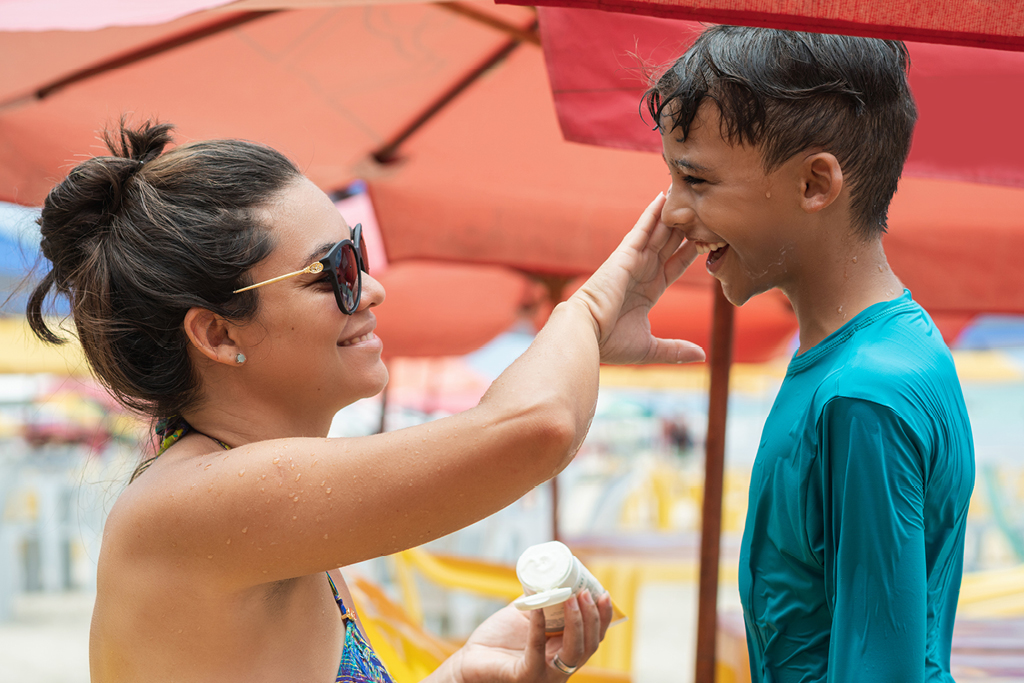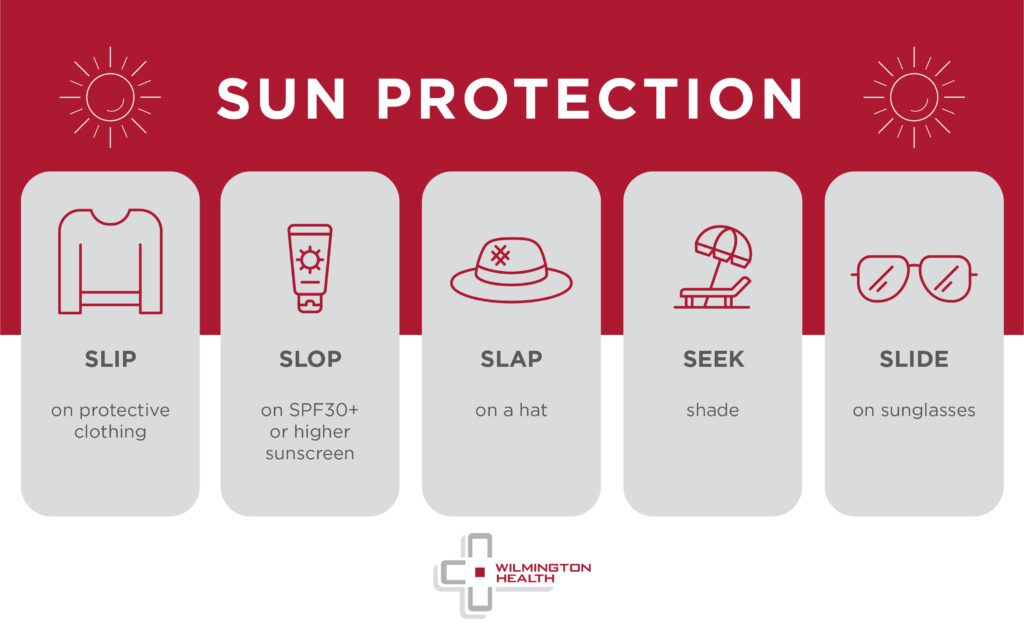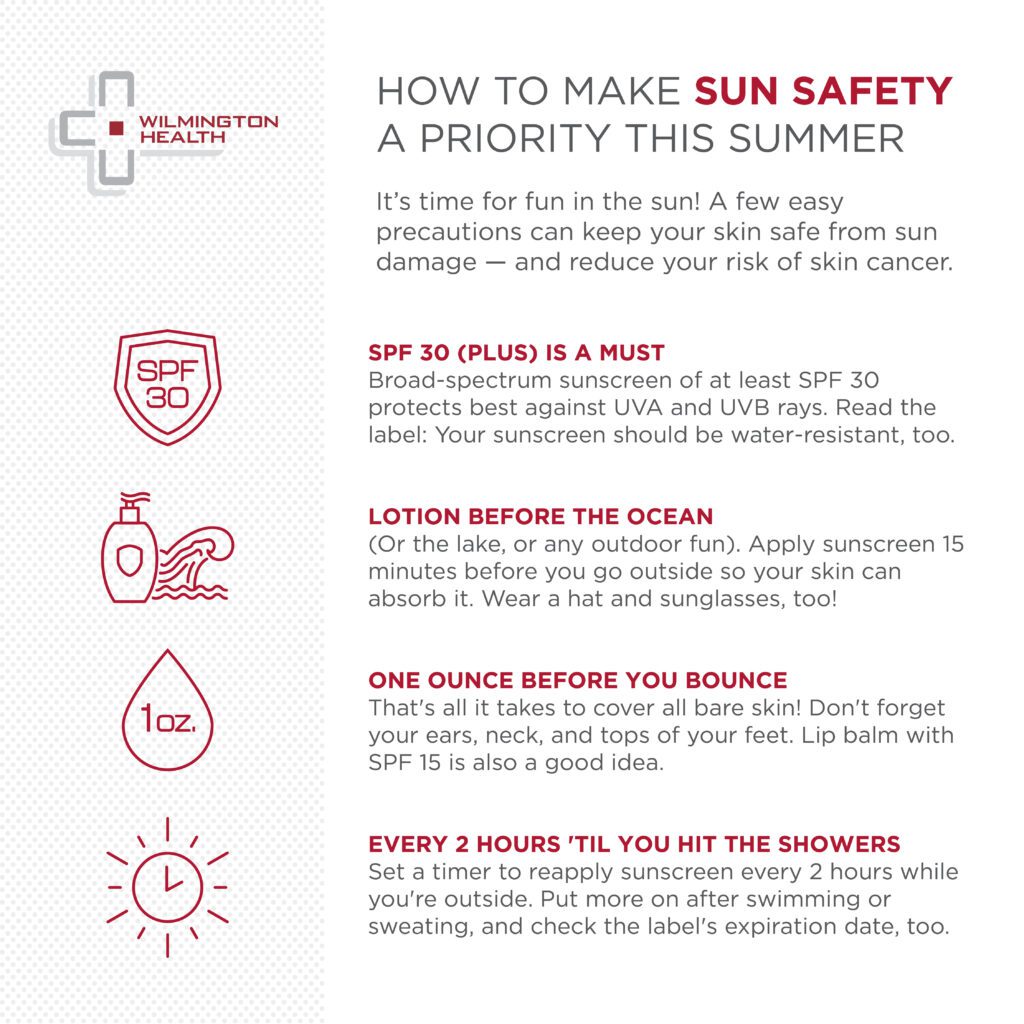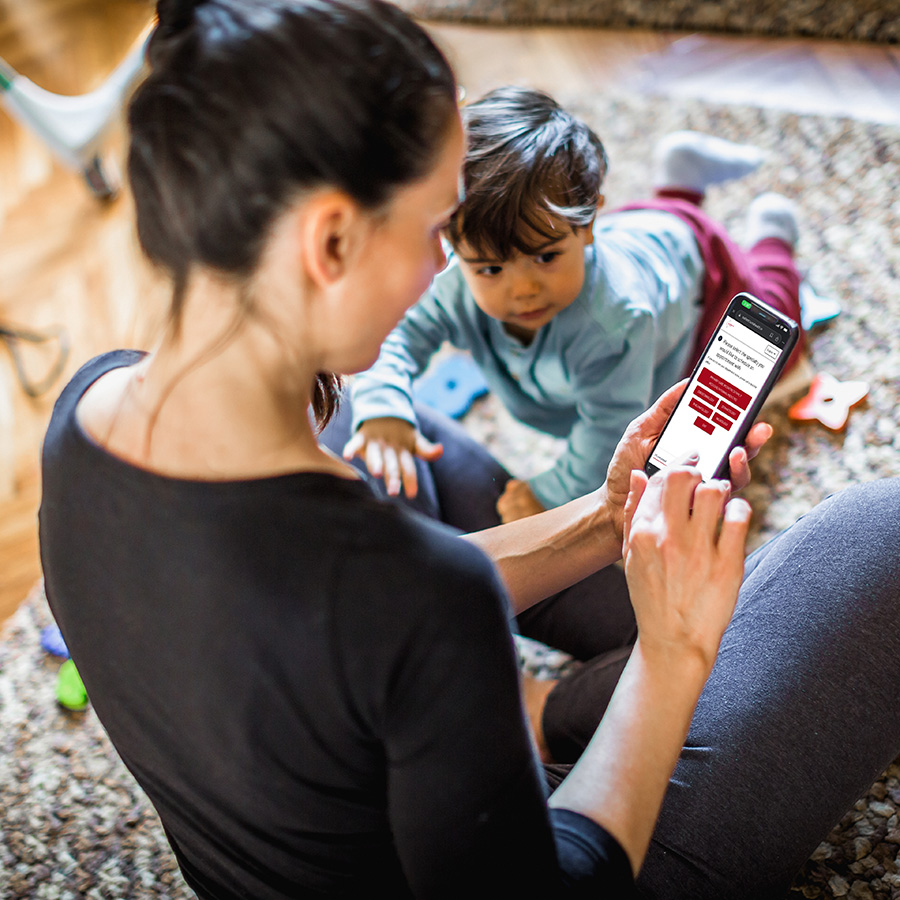
We often think we’re fine when we’re in the sun — until we’re not.
UV rays can be dangerous to your health, including harm to your eyes, immune system, and skin. It could also cause skin spots and premature skin aging, also known as photoaging.
Cancer is of the utmost concern. The Centers for Disease Control and Prevention says 4.3 million people get the most common skin cancers each year. These are basal cell carcinoma and squamous cell carcinoma.
But it’s easy to protect yourself and your children if you know a lot about sun safety. We’ll explore myths and truths about sun exposure, and even delve into the facts about tanning beds.
What are UV rays?
Exercising outside and staying active helps relieve stress. It exposes you to Vitamin D, which supports calcium absorption for healthier bones. You can also get Vitamin D through a balanced diet and vitamin supplements.
However, you also risk exposure to ultraviolet (UV) light. UV rays pose the most serious threat to causing skin cancer. They are invisible and are a form of solar radiation. They’re also found in sunlamps and tanning beds, and they can harm skin cells.
Studies show that tanning bed use before the age of 35 can increase the risk of skin cancer by 75%.
Some people might be at a higher risk of getting skin cancer from sun exposure. Factors contributing to that risk include the following:
- A family member who has had skin cancer
- Blond, red, or light brown hair
- Pale skin
- Previous treatment for skin cancer
How to protect yourself: Sun safety tips for adults
The UV index predicts the ray’s strength daily. A UV index of 3 or higher means you should protect yourself from sun exposure. There are several ways to protect yourself.
- Clothing. Articles of clothing can provide protection, such as:
- Beach coverups
- Long-sleeved shirts
- Pants
- Skirts
- T-shirts
The more of your skin you cover, the better. It is best to wear tightly woven clothing that is dry rather than wet. Dark colors are more protective than light ones.
- Hats. Those with a brim all the way around offer the most protection. Bucket and Legionnaire hats work best. They can shade the back of your neck, ears, and face. Woven canvas works better than straw hats that allow sunlight through. Darker hats protect effectively faster than lighter-colored hats. Baseball caps are helpful, but you’ll need protection for the back of your neck and ears. For more complete protection, you should:
- Stay in the shade
- Use sunscreen, and store it in a cool, accessible place
- Wear clothing that covers those areas
- Shade. Stay under shelter outside, such as a tree or umbrella. Use sunscreen or wear protective clothing, even in the shade.
- Sunglasses. They shield your eyes from UV rays and lower the risk of cataracts and protect the delicate skin around your eyes. The highest-quality sunglasses block UVA and UVB rays, and most sunglasses sold in the U.S. are made this way. Choose wrap-around models when possible to stop UV rays from getting to your eyes from the side. Also:
- Choose sunglasses with a UV400 rating or 100% UV protection on the label. That means they block 99% of UVA and UVB radiation. Darker lenses don’t guarantee enhanced protection.
- Do you wear tinted lenses? Ask your eye doctor if they have UV protection. Pupils dilate when you wear tinted lenses, and that can increase UV exposure to your retinas.
- You should wear quality sunglasses with UV protection even with UV-absorbing contact lenses.
- Sunscreen. It should be broad-spectrum, meaning it protects against both UVA and UVB rays. And it should be an SPF of 30 or higher. Apply it 30 minutes before you go outside, with a thick layer on uncovered skin. Combined with other options such as clothing, hats, and sunglasses, you’ll get the most effective results. Use mineral sunscreens with zinc oxide when possible. It deflects the sun’s rays, delivering instant defense against sun damage.
All about sunscreen
It can safeguard your skin and play a key role in preventing UV radiation exposure. But no sunscreen can block all UV rays, and not all sunscreens protect against UVA rays.
Sunblocks are different from sunscreens. They contain ingredients such as titanium dioxide and zinc oxide. These scatter and reflect UVB light.
Factors affecting sun safety include the following:
- SPF. It stands for sun protection factor. It’s an index that rates the ability to withstand UV rays. The higher the number, the more protection.
- Reapplication. You must put sunscreen on again after two hours of exposure if you sweat or during activities such as swimming and toweling off.
- Expiration date. Check it! If one isn’t listed, figure on a shelf life of fewer than three years. Containers stored at high temperatures will have a shorter shelf life.
- Volume: The average adult will need an ounce of sunscreen, equal to a shot glass full. Be sure to apply to exposed areas of your head, or wear a hat if necessary.
Schedule regular skin examinations. Note bleeding, changes, or growths. Alert your physician as soon as possible to any of these. The odds of treating skin cancer are much stronger when it’s caught early.

How to protect yourself: Sun safety tips for kids
At school, kids risk UV ray exposure at recess or during other outdoor activities. UV protection is a must. It’s up to parents, school administrators, and teachers to take precautions on behalf of the kids. Here’s how:
- Play in the shade. Structures such as picnic shelters and trees offer protection. Plan outdoor activities in shaded areas.
- Enable sun-safe activities: Motivate kids to wear hats, sunglasses, and sunscreen. Between 10 a.m. and 4 p.m., avoid outdoor activities. That’s when the sun is strongest. Give breaks to drink water and reapply sunscreen. No sunscreen is waterproof.
About SPF
An SPF 20 to 30 sunscreen will provide significant protection from sunburn and prevent a tan. They will protect against burning for longer. For reference, SPF 15 blocks 93% of UVB rays, and SPF 30 blocks 97%.
Set an example by practicing sun safety around children. For kids, sun safety follows many, but not all, of the same guidelines that are prescribed for adults. For example:
- Don’t use sunscreen on babies 6 months and younger. The U.S. Food and Drug Administration suggests keeping young kids out of the sun at midday. Also, dress them in protective clothing if exposure is inevitable.
Other precautions for kids include:
- Apply sunscreen 30 minutes before children go outside. It should be an SPF of 30 or more. This is true for children of all skin tones. Reapply every 2 hours after sweating or swimming. Test it on a child’s wrist before using it. If eye or skin irritation develops, try a different brand. Use caution when applying sunscreen around a child’s eyes. Don’t forget overlooked spots, such as:
- Back of the knees
- Back of the neck
- Lips (use lip balm with at least SPF 15)
- Rims of the ears
- Tops of the feet
- Be aware of heightened risks for some children. Kids with light hair, light-colored eyes, and fair skin can sunburn faster. Use an SPF 30 sunscreen or higher in those cases.
- Dress them in protective clothing. This includes the following:
- Long-sleeved shirts
- Pants
- Sunglasses
- Wide-brimmed hats
Clothing should have a UPF factor and be of tightly-woven material. Mesh or straw fabrics can allow harmful rays in. Select sunglasses that state on their labels that they provide UV protection.
- Know the signs of heat exhaustion. These include:
- Dizziness
- Headache
- Nausea
- Stomach cramps
- Weakness
Bring a child inside if any symptoms appear. Let them rest and give them plenty of fluids.
- Seek shade. The sun’s rays are strongest from 10 a.m. to 4 p.m. Hint: If a child’s shadow is shorter than they are, get in the shade.
- Watch out for sand, snow, and water. These elements can reflect harmful sun rays and increase the chances of sunburn.

The dangers of tanning beds
UV light causes the skin to change its tone by increasing melanin production. This is the body’s first reaction to guard against the sun, to soak up destructive UV rays. The result: sunburned skin, in places where the UV damage was greater than melanin’s protection.
Excessive sun exposure can be risky, so it’s advisable not to use a tanning bed if possible. Consider a self-tan product, but use sunscreen with it.
Discourage your teens from using tanning beds. Most use UVA bulbs, which can cause premature skin aging and cancer.
How to conduct a skin self-exam
Blood tests and X-rays aren’t needed to find skin cancer early. The American Cancer Society compiled this guide to check yourself.
FACE THE MIRROR
- Check your face, ears, neck, chest, and belly. Women will need to lift their breasts to check the skin underneath.
- Check your underarms, both sides of your arms, the tops and palms of your hands, in between your fingers, and under your fingernails.
SIT DOWN
- Check the front of your thighs, shins, tops of your feet, in between your toes, and under your toenails.
- Now use a hand mirror to look at the bottoms of your feet, your calves, and the backs of your thighs, first checking one leg and then the other.
- Use a hand mirror to check your buttocks, genital area, lower and upper back, and the back of your neck and ears. Or it might be easier to look at your back in a wall mirror using a hand mirror.
- If you want to check your scalp, you can use a comb or hair dryer to part your hair.
Do a skin self-exam after a bath or shower. Check for birthmarks, blemishes, or moles from head to toe. Looking at your skin regularly will make it easier to spot irregularities.
Myths vs. facts about sun safety
- You need to worry about UV rays only in the summer. Answer: MYTH. UV rays can reach you in the winter, too. They can bounce off cement, sand, snow, and water. They’re strongest from about 10 a.m. to 4 p.m., and about 80% of UV rays pass through on even the most overcast days.
- UVB rays can cause cancer more than UVA rays. Answer: FACT. But UVA rays can cause other issues, such as wrinkles and loss of elasticity. UVA also raises UVB’s detrimental effects, including cataracts and skin cancer risk.
- Over-the-counter and prescription drugs make the skin more sensitive to UV rays. Answer: FACT. You can develop a painful sunburn in minutes from some medications. Be sure to read the sunscreen labels before exposing yourself to the sun.
- One severe sunburn in childhood can double the risk of melanoma. Answer: FACT. Five or more such incidents between the ages of 15 and 20 can increase that risk to 80%.
- A base tan is good for me. Answer: MYTH. If the sun causes a change in your skin tone, that’s damage.
